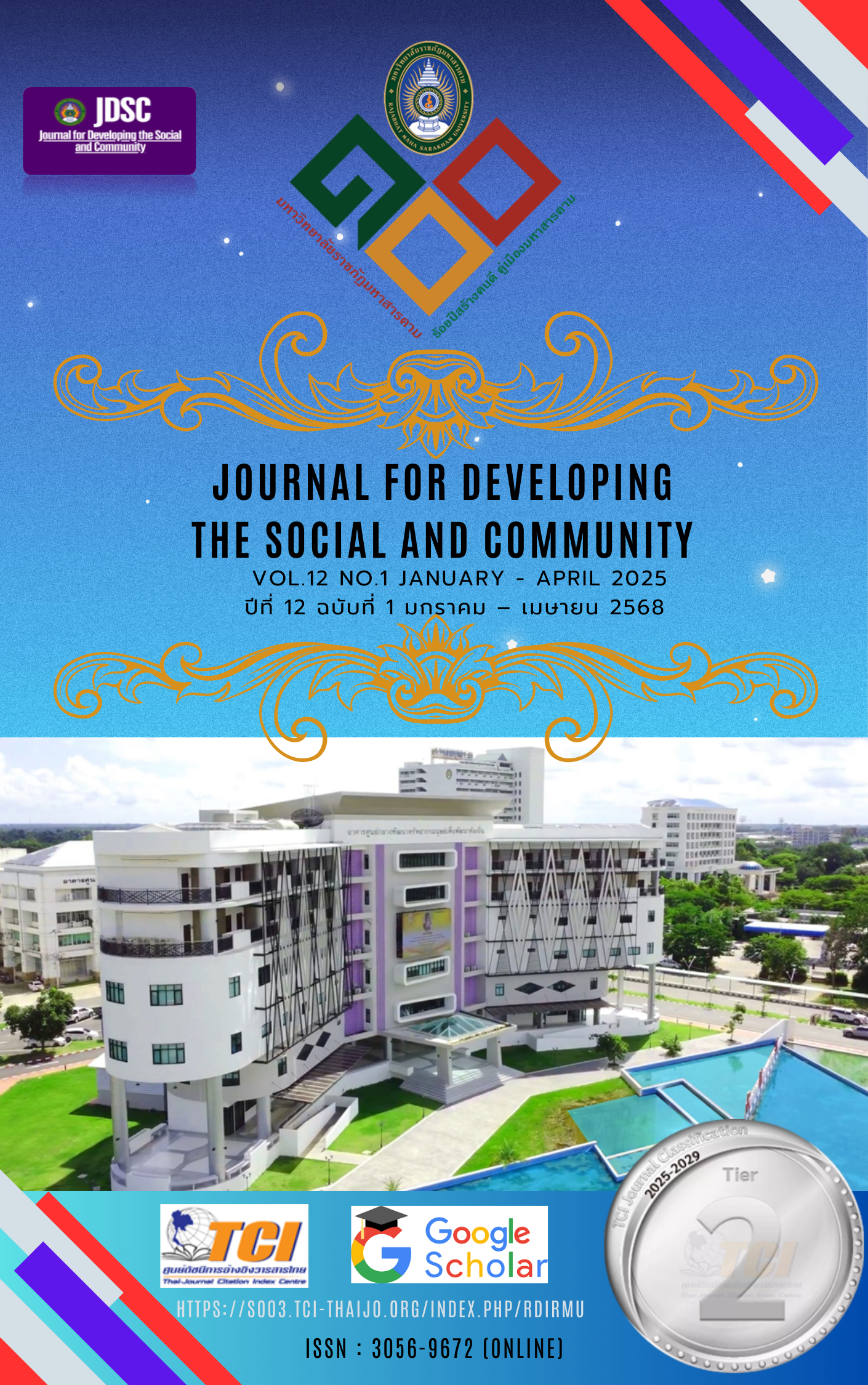The Image of Isan Region through the Online Public Relations Media of the Chinese Government: A Case Study of the Official WeChat Account of the Consulate General of the People's Republic of China in Khon Kaen
Keywords:
Isan region image, Chinese government public relations media, China–Thailand Isan relationsAbstract
Background and Aims: The Isan region is known for its rich cultural heritage, playing a significant role in tourism and economic development. However, its representation in Chinese media remains limited. This study aims to: 1) examine the roles and functions of Chinese government representatives in presenting content related to Isan’s arts, culture, and tourism through Chinese government public relations media, 2) explore the image of Isan as portrayed by these representatives, and 3) establish guidelines for utilizing public relations media to strengthen cultural and tourism relations between China and Isan.
Methodology: This study employs a mixed-methods approach, incorporating both quantitative and qualitative research. The qualitative analysis examines the roles and functions of Chinese government representatives in presenting content about Isan’s arts, culture, and tourism, as well as exploring the projected image and the strategic use of public relations media to enhance China–Isan relations. The quantitative analysis assesses the types of content and the frequency of media dissemination. The study analyzes online public relations content published by the Consulate-General of the People's Republic of China in Khon Kaen from July 7, 2024, to December 31, 2024, covering 34 original topics.
Results: Chinese government representatives play a crucial role in strengthening China–Thailand relations, encompassing cooperation in economic, educational, and tourism sectors. The official WeChat account, under the Chinese username "中国驻孔敬总领馆" presents content across various aspects. The three most frequently communicated topics in the public relations media are provincial image (41.1%), tourism (23.5%), and education (14.7%). The content dissemination strategy is structured, employing systematic communication approaches, carefully curated content, and engaging presentation. The frequency of posts ranges from 1 to 2 per day, with adjustments made to align with significant Thai festivals.
Conclusion: The role of Chinese government public relations media serves as a key intermediary in promoting the provincial image, disseminating knowledge on the distinctive arts and culture of the Isan region, and highlighting its educational landscape. The content is presented in a concise and engaging manner, with high frequency and consistent dissemination, particularly during significant periods and events.
References
กนกพร เล็งศรี. (2557). อัตลักษณ์อีสานในเพลงลูกทุ่งของ ไผ่ พงศธร. [วิทยานิพนธ์ปริญญาศิลปศาสตร์มหาบัณฑิต สาขาวิชาภาษาไทย]. มหาวิทยาลัยเชียงใหม่.
กระทรวงวัฒนธรรม. (2561). มรดกภูมิปัญญาอีสาน. ศูนย์วิจัยภูมิภาคลุ่มน้ำโขง: มหาวิทยาลัยมหาสารคาม.
เณรัญชรา กิจวิกรานต์. (2557). ภาพลักษณ์อาหารไทย การรับรู้คุณภาพอาหารไทยและแนวโน้มพฤติกรรมการท่องเที่ยวเชิงอาหารของนักท่องเที่ยวชาวต่างชาติ. วารสารวิชาการการท่องเที่ยวไทยนานาชาติ, 10(1), 12-28.
ธวัช ปุณโณทก. (2562). การศึกษาประเพณีพื้นบ้านอีสานในมิติของวัฒนธรรมร่วมสมัย. วารสารวัฒนธรรมไทย, 45(2), 123-145.
นิภากร กำจรเมนุกูล, และคณะ. (2567). การสร้างภาพลักษณ์ของมหาวิทยาลัยโดยสื่อสังคมออนไลน์. วารสารเกษมบัณฑิต, 25(1),1-15.
ปุญญ์นิรันดร์ อังศุธีรกุล, สิริพร ดงสิงห์, พศวรรตร์ วริพันธ์ และเสาวนีย์ สมันต์ตรีพร. (2566). แนวทางการส่งเสริมการท่องเที่ยวเชิงอนุรักษ์ กรณีศึกษา: เขตรักษาพันธุ์สัตว์ป่าทุ่งใหญ่- ห้วยขาแข้ง จังหวัดอุทัยธานี. วารสารวิชาการและวิจัย มหาวิทยาลัยภาคตะวันออกเฉียงเหนือ, 13(1), 84–98.
ผู้จัดการออนไลน์. (2558). เปิดเป็นทางการแล้วสถานกงสุลใหญ่จีนประจำขอนแก่นตอกย้ำความสัมพันธ์ไทย-จีนแน่นแฟ้น. ผู้จัดการออนไลน์.
สถานเอกอัครราชทูต ณ กรุงปักกิ่ง. (2565). ความสัมพันธ์ไทย-จีน. [ออนไลน์]. https://thaiembbeij.org/th/republic-of-china/thai-relations-china.
สิริลักษณ์ พฤทธิอานันต์. (2559). การออกแบบอัตลักษณ์ทางวัฒนธรรมเพื่อส่งเสริมการท่องเที่ยว อนุภูมิภาคลุ่มน้ำโขงไทยอย่างยั่งยืน. (วิทยานิพนธ์). มหาวิทยาลัยศิลปากร.
ศรีศักดิ์ วัลลิโภดม. (2560). วัฒนธรรมพื้นบ้านอีสาน. มหาวิทยาลัยธรรมศาสตร์.
อานนท์ สังวรดี. (2557). อัตลักษณ์อีสาน: วิถีชีวิตและวัฒนธรรม. (รายงานวิจัย). สำนักงานการวิจัยแห่งชาติ.
อานันท์ นาคคง. (2558). ประเพณีและพิธีกรรมในภูมิภาคอีสาน. อมรินทร์พริ้นติ้ง.
อิสระพงษ์ พลธานี, อุมาพร บุญเพชรแก้ว, และกุลธิดา นิมานบูรณวิจิตร. (2564). การส่งเสริมการท่องเที่ยวงานเทศกาลเที่ยวเมืองไทยผ่านข้อมูลสื่อออนไลน์. วารสารการบริการและการท่องเที่ยวไทย, 16(2), 1-15.
Boulding, K. E. (1975). The image: Knowledge in life and society. Michigan: The University of Michigan.
Cheng, H., Li, X. & Zhang, Y. (2019). Digital media and tourism: Exploring the impact of online promotion on cultural tourism. Tourism Research Journal, 33(2), 202-217.
Johnson, P. & Lee, Y. (2022). Building a positive image through online cultural promotion. Community and Culture, 10(1), 75-90.
Kotler, P. (2000). Marketing management. (Millennium ed). Prentice–Hall.
Miller, R. & Tan, K. (2020). Global connections through social media: Cultural exchange and awareness. International Journal of Media, 22(4), 55-68.
Reuters. (2011). Tencent launches WeChat messaging service. Reuters.
Smith, J. (2018). The role of online media in cultural preservation. Journal of Cultural Studies, 15(3), 112-130.
Wang, L. (2021). Educational use of online media for cultural awareness. Journal of Online Education, 14(1), 45-59.
Zhao, G. (2016). An Analysis on the US New Media Public Diplomacy Toward China on WeChat Public Account. Sociology Study. 6(1), 18-27.
Downloads
Published
How to Cite
Issue
Section
License
Copyright (c) 2025 Journal for Developing the Social and Community

This work is licensed under a Creative Commons Attribution-NonCommercial-NoDerivatives 4.0 International License.
Articles that are published are copyrighted by the authors of the articles







